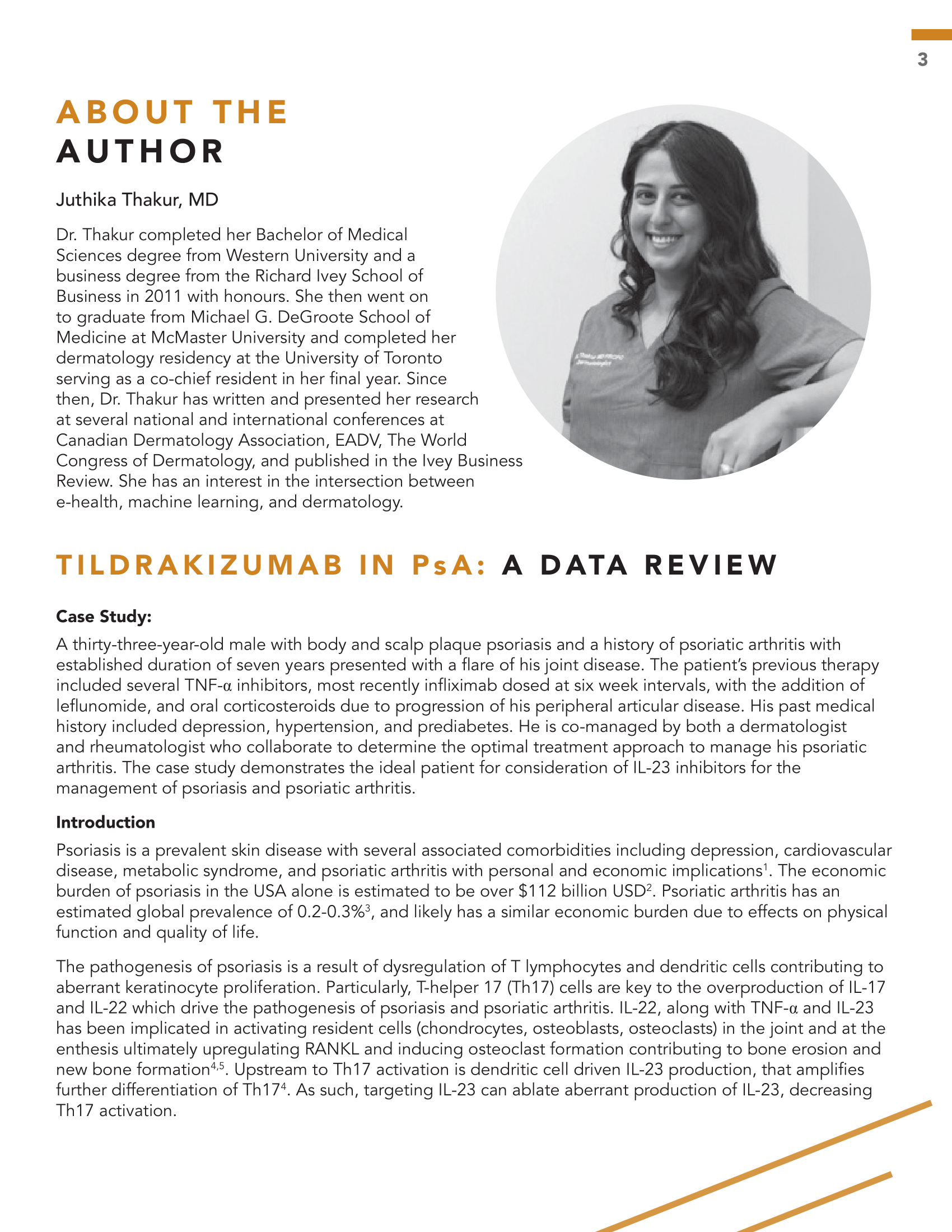Tildrakizumab In PsA: A Data Review
Abstract
Psoriasis is a prevalent skin disease with several associated comorbidities including depression, cardiovascular disease, metabolic syndrome, and psoriatic arthritis with personal and economic implications. The economic burden of psoriasis in the USA alone is estimated to be over $112 billion USD. Psoriatic arthritis has an estimated global prevalence of 0.2-0.3%, and likely has a similar economic burden due to effects on physical function and quality of life.
The pathogenesis of psoriasis is a result of dysregulation of T lymphocytes and dendritic cells contributing to aberrant keratinocyte proliferation. Particularly, T-helper 17 (Th17) cells are key to the overproduction of IL-17 and IL-22 which drive the pathogenesis of psoriasis and psoriatic arthritis. IL-22, along with TNF-α and IL-23 has been implicated in activating resident cells (chondrocytes, osteoblasts, osteoclasts) in the joint and at the enthesis ultimately upregulating RANKL and inducing osteoclast formation contributing to bone erosion and new bone formation. Upstream to Th17 activation is dendritic cell driven IL-23 production, that amplifies further differentiation of Th174. As such, targeting IL-23 can ablate aberrant production of IL-23, decreasing Th17 activation.
References
Rachakonda TD, Schupp CW, Armstrong AW. Psoriasis prevalence among adults in the United States. J Am Acad Dermatol. 2014;70(3):512- 516. doi:10.1016/j.jaad.2013.11.013.
Brezinski EA, Dhillon JS, Armstrong AW. Economic Burden of Psoriasis in the United States: A Systematic Review. JAMA Dermatol. 2015;151(6):651. doi:10.1001/ jamadermatol.2014.3593.
Ritchlin CT, Colbert RA, Gladman DD. Psoriatic Arthritis. Longo DL, ed. N Engl J Med. 2017;376(10):957-970. doi:10.1056/NEJMra1505557
Hawkes JE, Yan BY, Chan TC, Krueger JG. Discovery of the IL-23/ IL-17 Signaling Pathway and the Treatment of Psoriasis. J Immunol. 2018;201(6):1605-1613. doi:10.4049/ jimmunol.1800013.
Veale DJ, Fearon U. The pathogenesis of psoriatic arthritis. The Lancet. 2018;391(10136):2273-2284. doi:10.1016/S0140-6736(18)30830-4
Singh JA, Guyatt G, Ogdie A, et al. 2018 American College of Rheumatology/National Psoriasis Foundation Guideline for the Treatment of Psoriatic Arthritis. Arthritis Care Res. 2019;71(1):2-29. doi:10.1002/acr.23789.
Coates LC, Corp N, Van Der Windt DA, Soriano ER, Kavanaugh A. GRAPPA Treatment Recommendations: An Update From the 2020 GRAPPA Annual Meeting. J Rheumatol. 2021 Feb 15;jrheum.201681. doi: 10.3899/jrheum.201681. Online ahead of print.
Reich K, Warren RB, Iversen L, et al. Long-term efficacy and safety of tildrakizumab for moderate-to-severe psoriasis: pooled analyses of two randomized phase III clinical trials (re SURFACE 1 and re SURFACE 2) through 148 weeks. Br J Dermatol. 2020;182(3):605-617. doi:10.1111/ bjd.18232.
Mease PJ, Chohan S, Fructuoso FJG, et al. Efficacy and safety of tildrakizumab in patients with active psoriatic arthritis: results of a randomised, double-blind, placebo-controlled, multiple-dose, 52-week phase IIb study. Ann Rheum Dis. 2021 Sep;80(9):1147-1157. doi: 10.1136/annrheumdis-2020-219014. Epub 2021 May 13.
Deodhar A, Gottlieb AB, Boehncke WH, et al. Efficacy and safety of guselkumab in patients with active psoriatic arthritis: a randomised, double-blind, placebo-controlled, phase 2 study. The Lancet. 2018;391(10136):2213-2224. doi:10.1016/S0140-6736(18)30952-8.
Nash P, Luggen ME, Ferran JGF. Proportions of patients achieving a minimal disease activity state upon treatment with tildrakizumab in a psoriatic arthritis phase 2b study. Poster Presentation presented at the: American College of Rheumatology Convergence. 2020 November 5.
Chohan S, Kavanaugh A, Strand V. Efficacy of Tildrakizumab in PsA: DAPSA Remission and Low Disease Activity in PASDAS Through Week 52. Poster Presentation presented at the: American College of Rheumatology Convergence. Virtual Presentation. November 5-9.
Yang K, Oak ASW, Elewski BE. Use of IL-23 Inhibitors for the Treatment of Plaque Psoriasis and Psoriatic Arthritis: A Comprehensive Review. Am J Clin Dermatol. 2021;22(2):173-192. doi:10.1007/s40257-020-00578-0.


